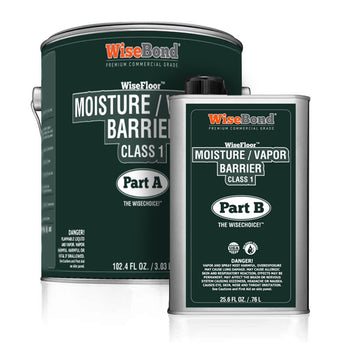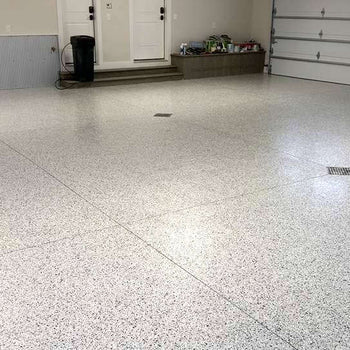

This moisture blocker can be applied between 3 to 5 mils making a gallon go over 300 square feet depending on concrete floors surface conditions. Used as a primer coat, WiseBond’s Moisture and Vapor Barrier will help keep moisture and air from coming up from concrete floors, eliminating unwanted bubbles and pinholes when applying epoxy, polyurethane floor coatings.
This product is only applied after a calcium chloride test reveals a concrete floor moisture level is above 12 psi per 1000 sq. ft.
WiseBond’s Concrete Moisture Barrier and Vapor Blocker is a 2 component solvent-based urethane primer, 97% solids, low VOC (<40 g/L), class 1 vapor barrier that meets ASTM-E96-E93. This product stops water vapor transmission, to less than 1/2 pound per 1,000 sq. ft. This unique water vapor barrier opens up the possibility of applying high-performance resinous coatings to uncured or moisture-laden concrete that was never before possible.
WiseBond’s Concrete Moisture Barrier and Vapor Blocker penetrates without blistering into the concrete’s porous surface to generate mechanical interlock and superior bonding that follow its application. Bond strength exceeds that of traditional epoxy primers.
Offers these advantages when applied in advance of any WiseBond Coatings:
The principles for surface preparation for the Concrete Moisture Barrier and Vapor Blocker t addressed with the required surface preparation for the WiseBond system selected. The surface must be clean, sound, and profiled, prior to application. This product is not a shortcut for poor surface preparation!
Apply when surface and ambient temperatures range between 50 F (10 C) and 90 F (32 C) and will remain that way for 24 hours.
Select appropriate PPE (personal protection equipment). Provide adequate ventilation. Refer to SDS. Work across the narrowest dimension of an area where practical. Work to an exit from the wet product. Track coverage rate for each gallon (3.8 liters). After establishing room dimensions, before mixing commences, place a short piece of masking tape on the wall to correspond to the “distance” one gallon should cover. The moisture barrier and vapor blocker should be acclimated to room temperature, before application. Ideal room temperature is 78 degrees and 50% relative humidity.
NOTE: Mask all areas requiring protection; product will stick to just about everything.
Step 1: Organize mixing station that neither has to relocate, nor block the progress of applications. Staging is critical so that Part “A” and Part “B” are not confused with one another or mixed too far in advance. Once A and B are mixed, the catalyzed product should be placed on the floor immediately. If left in the pail too long, the product will cure at an accelerated rate rendering it useless.
Step 2: Pour 1 part B into three parts A. Note that kits are premeasured for convenience whereas Part A container is short-filled to accept Part B. Exercise care to avoid pouring product down the sides of the pail, as this will be difficult to mix.
Step 3: Mechanically mix both parts A and B mechanically for 5 minutes at medium speed. Slow to medium speed will help prevent air entraining.
Step 4: Pour contents completely out in a relatively long trail for an application. Any unused portion left in the container can cure at an accelerated rate rendering it useless.
Step 5: Do not leave bucket upside down to drain onto the floor. Any unmixed portion of A or B that may have accidentally been placed on the side of the container can now drain down onto the floor, creating a spot that will not cure.
Concrete Moisture Barrier and Vapor Blocker may be applied with a paint roller or squeegeed and then backrolled.
Step 1: Select nap size approximately 3/8” using a 12"-18" frame roller. Rollers should be superior quality with a phenolic core. “De-fuzz” roller by wrapping tightly with masking tape and removing the tape.
Step 2: Large areas may require 18” (46 cm) rollers and wider squeegees. Spread product evenly over the area, areas adjacent to walls may be “cut in” by brush, apply no more than 3-5 mils wet.
Step 3: Allow to dry to the touch and tack-free (approximately 4 – 6 hours) before applying epoxy flake floor system but not longer than 24 hours prior to epoxy application. If allowed to dry past 24 hours, the surface must be screened sanded with a 100 grit sanding screen on a rotational floor machine, and reapplied.
The concrete Moisture Barrier and Vapor Blocker can be cleaned up with a solvent such as a xylene or acetone.
Do not apply on visibly wet or moist concrete.
Contact your local government household hazardous waste coordinator for information on disposal of unused product. Upon curing, left over catalyzed product is not hazardous.
Solids: 96.5%
VOC Rating: < 40 g/L
Tack Free Time: 4 1/2 hours at 78 F
Water Vapor Transference: < .02 (ATSM E-96-93)
Water Permeance: < .1
Adhesion to Dry Concrete: 621 psi (ASTM-D4541-65)
Adhesion to Wet Concrete: 621 psi (ASTM-D4541-65)
© 2026 - WiseBond®, A product of DeckWise®, The Ipe Clip® Fastener Company